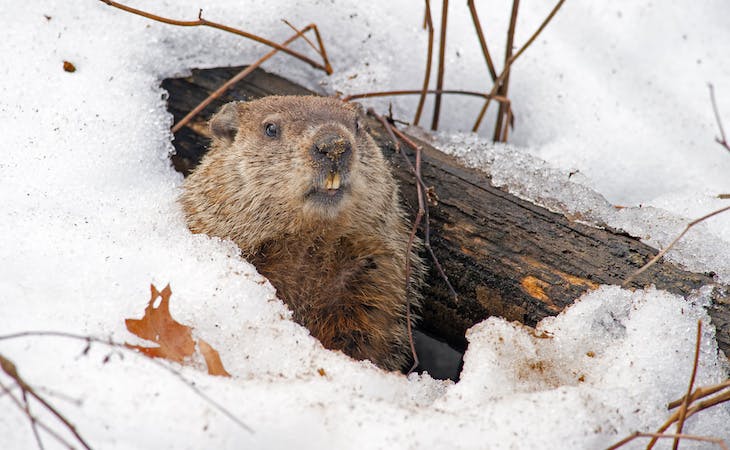Groundhog Hibernation: Unveiling Nature’s Winter Sleep Secrets
Have you ever wondered what happens to groundhogs when winter arrives? You might think they just disappear, but there’s a fascinating secret behind their behavior—hibernation.
Understanding groundhog hibernation can change the way you see these furry creatures and even give you clues about the changing seasons. If you want to discover how groundhogs prepare for the cold, what keeps them safe and warm, and why their hibernation matters, keep reading.
This simple yet surprising process holds more mystery than you might expect—and it’s easier to grasp than you think.
Groundhog Hibernation Basics
Groundhogs, also called woodchucks, spend a large part of the year in hibernation. This is a deep sleep that helps them survive cold winters. During hibernation, groundhogs slow down many body functions. They stay in their burrows, safe and warm. Understanding how groundhogs hibernate reveals their amazing survival skills.
What Happens During Hibernation
Groundhogs enter hibernation in late fall. They prepare by eating a lot to store fat. Once inside their burrows, they sleep for months. Their body temperature drops close to the ground temperature. Heart rate slows down dramatically. Breathing becomes very slow. These changes save energy through the cold season. Groundhogs wake up in early spring when it gets warmer.
Physiological Changes In Groundhogs
During hibernation, groundhogs experience big changes inside their bodies. Their heart rate drops from about 80 beats per minute to just a few. Breathing slows to only a few breaths each minute. Body temperature falls from around 99°F to near 40°F. Metabolism slows, reducing energy use. Fat stored before winter becomes their main fuel. These changes help groundhogs survive months without eating or drinking.
Triggers For Hibernation
Groundhogs prepare for hibernation through certain triggers. These signals help them know when to slow down and rest. Two main triggers affect their behavior. One comes from outside, the other from inside their bodies.
Environmental Cues
Groundhogs notice changes in the environment. Shorter daylight hours tell them winter is near. Cooler temperatures also signal hibernation time. Food becomes scarce, pushing groundhogs to rest. They react to these signs by eating more. This helps them build fat for the long sleep ahead.
Internal Biological Clocks
Groundhogs have natural body clocks called circadian rhythms. These rhythms control daily and seasonal patterns. They help groundhogs know when to hibernate. The clock works even if the weather is warm. It triggers changes like slowing down heart rate and metabolism. This internal timing keeps hibernation on track every year.
Groundhog Burrow Preparation
Groundhogs prepare their burrows carefully before hibernation. These burrows protect them from cold temperatures and predators. The process starts weeks before winter arrives. Groundhogs pick the best spot and then make important changes to their burrows. This preparation helps them stay safe and warm during hibernation.
Selecting The Ideal Site
Groundhogs choose burrow sites with care. They prefer areas with soft soil for easy digging. The site must drain well to avoid water inside the burrow. Groundhogs look for places near food sources like plants and grasses. They avoid busy areas to stay hidden from predators. The location needs to be quiet and safe.
Modifications For Winter
Before winter, groundhogs make changes inside the burrow. They dig deeper tunnels to reach warmer soil. The main chamber becomes larger and lined with dry leaves and grass. These materials act as insulation against cold. Groundhogs block some tunnel entrances to keep cold air out. They create small air holes for fresh air. These changes make the burrow cozy and safe.
Energy Conservation Strategies
Groundhogs use smart ways to save energy during hibernation. Their bodies slow down to last through winter. This helps them survive with little food or water. Energy conservation is key to hibernation success.
Metabolic Rate Reduction
Groundhogs lower their metabolic rate drastically. This means their body uses less energy. Heart rate and breathing slow down a lot. Less energy is needed to keep the body alive. This slow metabolism helps groundhogs stay in hibernation longer.
Body Temperature Regulation
Groundhogs drop their body temperature close to the cold ground. This reduces energy used to keep warm. Their temperature can fall just above freezing. Low body temperature slows down body functions. It helps save more energy during hibernation.
Hibernation Duration And Patterns
Groundhogs spend a large part of the year in hibernation. Their sleep helps them survive cold winters with little food. Understanding their hibernation duration and patterns reveals how they stay alive. These patterns also show how groundhogs adapt to changing weather.
Hibernation is not just one long sleep. It has phases and breaks that serve different purposes. Knowing these phases helps explain how groundhogs manage energy and body functions during winter.
Length Of Winter Sleep
Groundhogs hibernate for about three to six months. The exact length depends on climate and location. In colder areas, hibernation lasts longer. Warmer regions see shorter hibernation periods. Groundhogs enter burrows by late fall. They stay until early spring, avoiding harsh cold.
During this time, their heart rate and breathing slow down. Body temperature drops to save energy. This deep sleep helps groundhogs live without eating much food. The length of sleep matches winter’s harshness and food scarcity.
Intermittent Arousals
Groundhogs do not sleep continuously during hibernation. They wake up briefly several times. These short arousals last a few hours. During these times, groundhogs raise their body temperature. They may move around inside their burrow.
These breaks help with waste removal and muscle health. They also allow the groundhog to check the environment. After arousal, groundhogs return to deep sleep. These cycles repeat until winter ends.

Credit: ispyphysiology.com
Impact On Ecosystems
Groundhogs hibernate for several months each year. Their hibernation has a clear effect on the environment. It changes how other animals and plants live and grow. The break in their activity gives a balance to the ecosystem.
Role In Soil Aeration
Groundhogs dig deep burrows. These tunnels let air reach the soil below. This helps plants grow stronger roots. The soil also holds water better. Good soil means healthier plants around the burrow.
Their digging moves old soil to the surface. This recycles nutrients for plants. It also stops the ground from getting too hard. This makes the land better for other small animals.
Influence On Predator-prey Dynamics
Groundhogs serve as food for many predators. When they hibernate, predators look for other prey. This shift can change hunting habits. Some predators may hunt less or move to new areas.
Groundhog hibernation also gives prey animals a chance to grow. With fewer predators around, some species increase in number. This impacts the whole food chain and keeps it balanced.
Comparisons With Other Hibernators
Groundhogs are famous hibernators, but many animals hibernate too. Comparing groundhogs to other hibernators helps us understand their unique habits. Different animals hibernate in different ways to survive cold months. Some stay deep underground, others use fat stored in their bodies. Groundhogs have special traits that set them apart.
Similarities And Differences
Groundhogs and bears both lower their body temperature during hibernation. Their heart rates slow down to save energy. Both live in dens underground or in natural shelters. Unlike bears, groundhogs enter a deeper sleep and stay inactive longer. Some animals, like bats, hibernate in caves while groundhogs prefer burrows. Groundhogs wake up more slowly than many other hibernators. These small differences help each animal survive in its own way.
Unique Adaptations Of Groundhogs
Groundhogs store large amounts of fat before winter. Their burrows have special chambers to stay warm and dry. They can lower their body temperature to just a few degrees above freezing. Groundhogs reduce their breathing rate to only a few breaths per minute. Their muscles stay healthy despite long inactivity. These adaptations allow groundhogs to survive long cold winters underground safely.

Credit: ispyphysiology.com
Human Interaction And Myths
Groundhogs have a special place in human culture. People have many stories and beliefs about their hibernation habits. These tales often mix facts with myths. Understanding how humans interact with groundhogs helps clear up confusion. It also shows how these animals became a part of popular tradition.
Groundhog Day Traditions
Groundhog Day is a well-known tradition in North America. It happens every February 2nd. People watch a groundhog come out of its burrow. The belief is that if the groundhog sees its shadow, winter lasts six more weeks. No shadow means an early spring. This event draws large crowds and media attention. It is a fun way to celebrate the end of winter.
The tradition started in the 1800s. German settlers brought the idea from Europe. They used a hedgehog before switching to the groundhog. The animal’s hibernation is a sign that nature is changing. This tradition mixes cultural history with animal behavior.
Common Misconceptions
Many people think groundhogs sleep all winter without waking up. In truth, they wake up sometimes during hibernation. They may eat a little or move inside their burrows. Hibernation is more like deep sleep than complete unconsciousness.
Another myth is that groundhogs predict the weather accurately. Their shadow may not really tell us how long winter lasts. Weather depends on many factors that an animal cannot control. The day is more about fun and tradition than real forecasting.
Some believe disturbing groundhogs during hibernation can harm them. While it is best to avoid waking them, groundhogs can survive short disturbances. Respecting their space helps them stay healthy.
Scientific Research And Discoveries
Groundhog hibernation has fascinated scientists for many years. Researchers study how these animals survive cold winters. Their bodies slow down to save energy. This natural process helps groundhogs live through months without food. Scientific research uncovers new facts about this amazing ability. These discoveries also help us understand hibernation in other animals.
Recent Studies On Hibernation
Scientists have used new tools to study groundhog hibernation. They observe changes in body temperature and heart rate. These studies show how groundhogs reduce energy use. Researchers also examine how their brains stay active during hibernation. Some studies reveal how groundhogs avoid muscle loss. This helps them stay strong after waking up.
Implications For Medicine And Biology
Understanding hibernation can help human medicine. It may lead to better treatments for injuries and illnesses. Scientists explore how to protect organs during low blood flow. This knowledge could improve surgeries and emergency care. Hibernation research also helps biology. It explains how animals adapt to harsh environments. These insights might guide conservation efforts for many species.

Credit: www.saatva.com
How Smart Pets Lover Can Help You with Groundhog Hibernation
Exploring Groundhog Hibernation: A Hands-On Learning Experience
Understanding groundhog hibernation opens up fascinating practical learning opportunities, especially when exploring their burrow preparation and energy conservation strategies. Observing how groundhogs carefully prepare their underground homes can inspire pet parents to think about creating cozy, safe spaces for their own furry companions during colder months.
By comparing groundhogs’ seasonal behavior with that of other hibernators, you can deepen your appreciation for nature’s rhythms and how animals adapt to their environment. This knowledge also encourages responsible observation—learning not to disturb wildlife while satisfying curiosity.
- Try journaling seasonal changes in your backyard or local park to spot signs of animal hibernation patterns.
- Discuss with fellow pet lovers how these natural cycles might affect your pets’ activity and care routines.
- Explore research findings to better understand animal biology and behavior, fostering empathy and connection.
At Smart Pets Lover, we believe that every discovery about animals enriches the bond between pet parents and their companions. For more insights or questions about animal behaviors, feel free to reach out via our contact page—helping you feel informed and connected is at the heart of our mission.
Frequently Asked Questions
What Is Groundhog Hibernation?
Groundhog hibernation is a deep sleep lasting months. Groundhogs slow their metabolism, lower heart rate, and conserve energy. This helps them survive cold winters with limited food.
When Do Groundhogs Start Hibernating?
Groundhogs usually begin hibernation in late October or November. They prepare by eating a lot to build fat reserves. Hibernation lasts until early spring, around February or March.
How Long Do Groundhogs Hibernate?
Groundhogs hibernate for about three to four months. The exact duration depends on climate and temperature. They wake up when the weather warms and food becomes available.
Do Groundhogs Wake During Hibernation?
Yes, groundhogs occasionally wake during hibernation. They may briefly increase body temperature and heart rate. These short arousals help maintain bodily functions before returning to sleep.
Conclusion
Groundhogs sleep deeply during winter to save energy. Their bodies slow down, and they stay warm underground. This hibernation helps them survive cold months without food. Watching groundhogs can teach us about nature’s rhythms. Next time you see one, remember its long winter rest.
Understanding hibernation shows how animals adapt to tough seasons. Nature is full of amazing survival tricks like this. Groundhog hibernation is a simple, smart way to live through winter.





